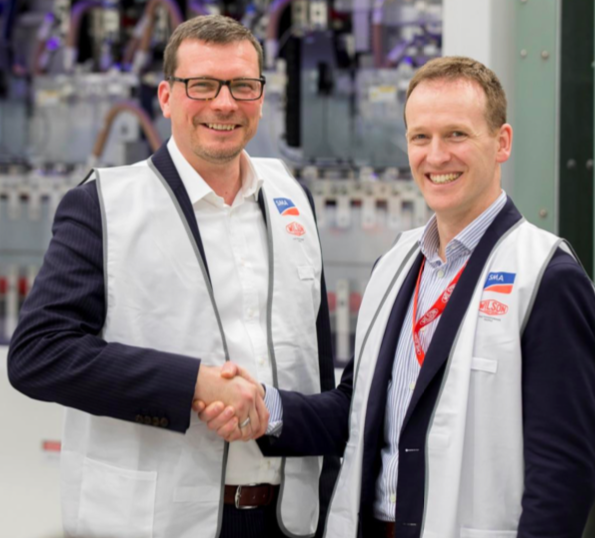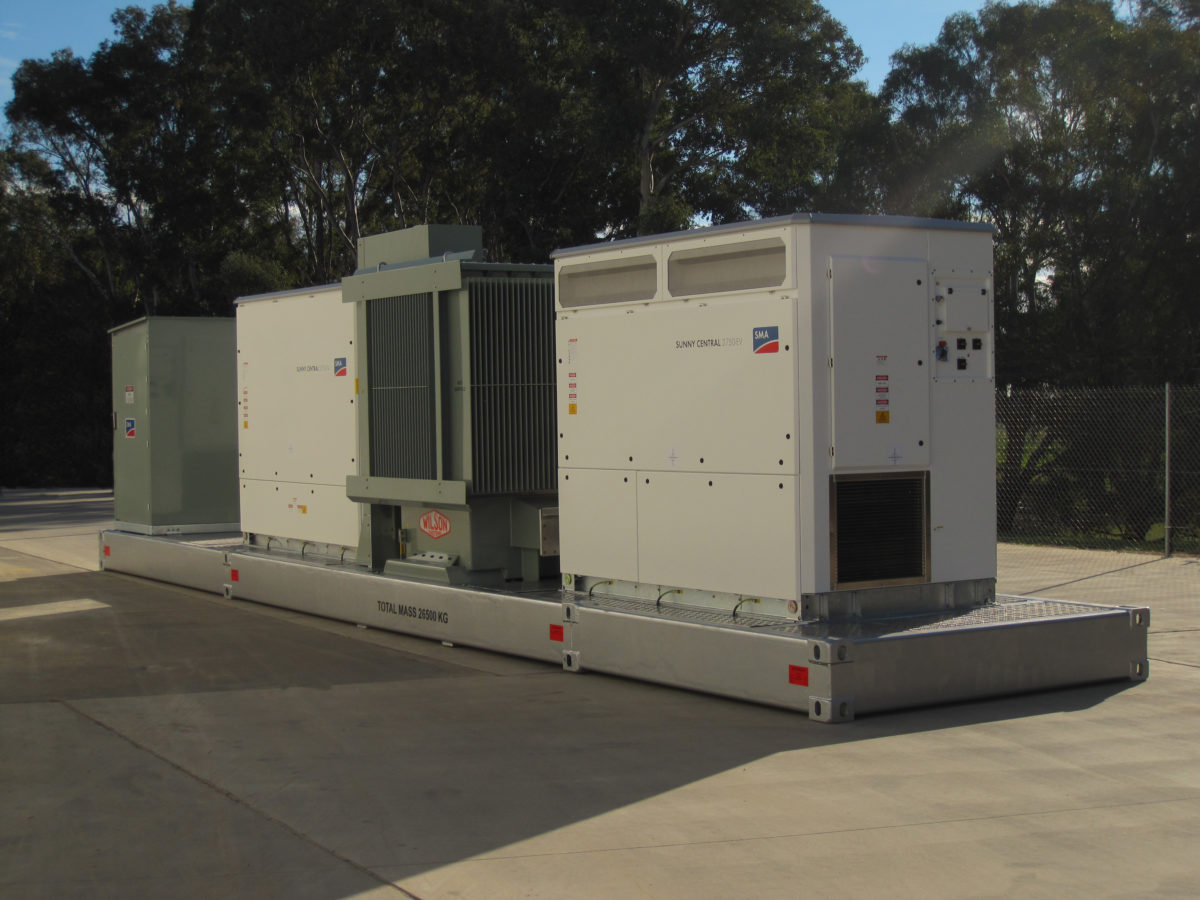pv magazine Australia: SMA has enjoyed pretty dominant market share in the Australian marketplace in the past. That puts you in a pretty good position to assess the progress being made in the large-scale market segment. How would you describe things in 2019?

Photo: SMA Solar Technology
Boris Wolff: My perception is that there was quite a rush with projects being executed through to the end of 2018 and then we felt that things went pretty quiet. My feeling was that this was because of regulatory standards that were revised and redefined.
Since the beginning of this year many of our customers are talking about new projects – and they are coming in. When I was last in Australia, that was in March of this year, there were quite a lot of quite large projects under discussion – and I’m talking about the 400 MW to 700 MW range. We were questioning how realistic these projects were, particularly with regards to grid connection. To our surprise, and we had a conservative estimation 18 months ago, we see now that there are more projects than originally anticipated in the pipeline and they are materializing.
So, overall, it’s quite positive. Beyond pure PV, storage is also being actively considered by almost all developers. We still see a good market development in terms of large scale projects for the next two years and from two years on with an increased penetration of storage in the PV plants as well.
Would you say that this represents a transition of projects that were being developed with subsidies, in the form of LGCs, to those that are driven more on a pure PPA or even merchant basis?
That’s more difficult to judge. It really depends on which customer [of SMA’s] that you’re talking to. My impression, and I’m confident that it’s representative, many customers today are merchant and PPA driven rather than subsidy.
Does this change the nature of discussions regarding components like the inverter?
I don’t know whether we would see that. In the first wave of Australian projects we were involved from the very early stages of project development and supporting with technical questions – including grid studies. That is what we are continuing to do now. Even if the decision-making process is more long-term orientated now, I don’t have the feeling that this is noticeable for us.
We have been in discussions with developers from quite early on [in the project development process] and we were deeply involved with them – and we continue to do so. My general impression is that there has been a global trend in the large scale segment over the last two years that has been to go to short term orientated and to make low-cost purchasing decisions – but this is changing now. I expect this to be the case in Australia as well. It might not be noticeable for us because we’ve been involved with long-term orientated partners in the first wave also.
You mentioned regulatory standards, I imagine you’re referring to changes that were related to grid connection. As an inverter supplier you are on the front line of that process. How would you describe the challenge of grid constraints in Australia at the moment for solar projects?
Definitely the biggest challenge, besides special weather conditions, is the grid connection challenge for most projects and stakeholders. As an inverter supplier, we play a very important role, as we are the brains, together with the power plant controller, of the system. All stakeholders, including suppliers and the regulator, were completely overwhelmed by the challenges associated with the first wave of PV projects in Australia.
One of the lessons learned [from this first wave of projects] is that we and need and our customer needs to involve the regulator in the very early stages of project developer – rather than in the hot phase, which is the R2 testing phase. Along with that, we need to have a better setup, from a supplier point of view, to answer questions from the regulator and EPC.
To meet this need, at SMA we have increase staff in Australia and in our HQ with grid connection and operation competence. And I have to say that that is a highly specialized skill set. We have even developed a special engineering support [service offering] for customers, not just for Australia but for our global clients – but it’s largely been derived from that experience [in Australia]. We support the developer and the consultants with grid modeling in a very early stage.
You say based on experience, so in the Australian market you’ve experienced how things can wrong with grid connection? We have heard about many projects that have been delayed at this stage of development.
We have certainly been confronted with grid studies that have been developed without a deep knowledge of requirements, and then the EPC and developer were struggling later on. In these situations they were left with work or projects that were poorly prepared by the consultants during development.
Based on that, it’s clear how important it is that we are involved early. We provide engineering services to support the developer and have set up a scheme for a very competitive price to do that and to significantly reduce the risk.
So what does it mean for an EPC or developer perspective, what does this service attempt to do and I’m sure that must also bring with it costs?
We support the grid study. As the inverter manufacturer is at the later stages on the hook to get the project up and running, we would prefer to be involved upfront.
We have seen a blame game with the developer and consultant, the EPC and inverter manufacturer. When the finger is being pointed in terms of whose fault it is that the modeling doesn’t match the real world. The inverter manufacturer knows very well what the models it is providing is going to be used for, so it’s better to take control of the studies and models to ensure that it is done on the proper and correct way. The grid study might cost, but the risk if it goes wrong is literally millions.
We have established [the capacity for] that level of engineering support at the beginning of this year, and the first orders are coming in. We really have increased our resources to support our customers better.
We know that Australia’s grid is particularly long and skinny, and we’ve seen wind and solar grow very rapidly. Are these the kind of services that you expect to be required in other markets as well in the future?
We see Australia as a blueprint, as other countries with similar problems emerge, perhaps maybe not to quite the same extent. But there will be other places where the same conditions are in place – a high penetration of renewables and a weak grid. Perhaps the ratios are unique in Australia, but we will have this problem and we see this problem in other parts of the world also.
It’s been a pretty turbulent time in the EPC segment in Australia over the last 12-18 months, with some non-specialized EPCs running into problems. Are you confident now that mistkaes of the past won’t be replicated for a second time?
The biggest risk I currently see is new, inexperienced EPCs, but different from the first wave. These new EPCs may be experienced in other parts of the world in solar development where the conditions are not so challenging and there is quite a risk.
Previously, we have seen a lot of Australian EPCs that had experience in another industrial segments and that presented a challenge for them when they came to PV. Now solar EPCs from other parts of the world not familiar with the grid conditions are getting involved in the [Australian] market. This is something we keep working at: To convince them that they should accept the experience of a supplier to the Australian market for more than two years and has gone through the experience and learning curve we went through, with our partners. They really can benefit from it and I think this extremely important.
This content is protected by copyright and may not be reused. If you want to cooperate with us and would like to reuse some of our content, please contact: editors@pv-magazine.com.









By submitting this form you agree to pv magazine using your data for the purposes of publishing your comment.
Your personal data will only be disclosed or otherwise transmitted to third parties for the purposes of spam filtering or if this is necessary for technical maintenance of the website. Any other transfer to third parties will not take place unless this is justified on the basis of applicable data protection regulations or if pv magazine is legally obliged to do so.
You may revoke this consent at any time with effect for the future, in which case your personal data will be deleted immediately. Otherwise, your data will be deleted if pv magazine has processed your request or the purpose of data storage is fulfilled.
Further information on data privacy can be found in our Data Protection Policy.